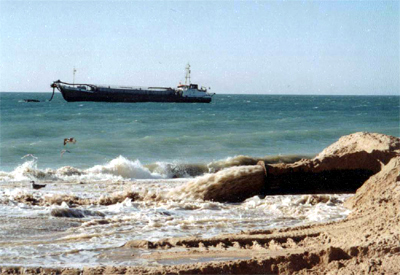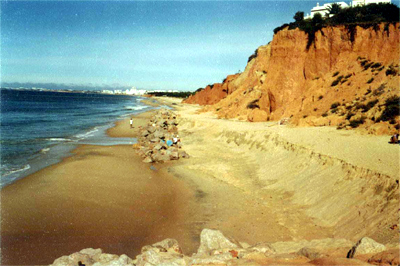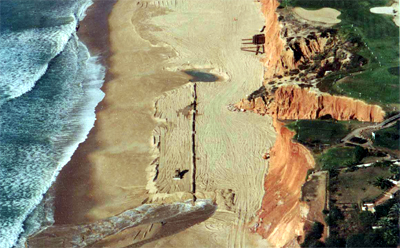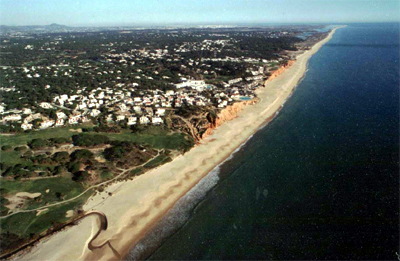Artificial nourishment
Contents
Introduction
Tina Mertens is working on this topic. Please be patient.
Beach nourishments
Shoreface nourishments
Application
Conditions
Examples
- Belgium
- Denmark
- France
- Germany
- Greece
- Italy
- Norway
- Poland
Vale do Lobo beach, Algarve - Portugal
The information gathered in this section features in Veloso Gomes et al. (2005) [1].
General description of the area
Vale do Lobo beach is located on the south Portuguese Coast at Quarteira, between Albufeira and Faro in the district of Loulé, about 5km east of Vilamoura.
Geology
The cliffs of Vale do Lobo beach are almost vertical formations of red Pleistocene sands.
Morphology of the coast
This shoreline stretch is characterised by a set of high cliffs, composed of highly fractured formations with weak cohesion, and a narrow subjacent beach. The base of the cliffs is often hit by breaking waves, especially in winter. The width of the subjacent beach is the main factor on which the evolution of the cliffs depends, as it is the main protection against waves breaking directly on the cliffs.
Physical processes
Along the south Portuguese coast the sea currents generated by the wind or the tides are negligible in relation to the drift currents generated by the waves. The breaking wave currents are comparatively low in the intervention area, in the range of 0.25 to 0.5m/s. On the downdrift area wave breaking currents can reach values of around 2m/s.
The typical values for tides are the following (INAG, 1997) [2]:
- Average tide level: +2.00m (HZ);
- Spring tides:
- Maximum high tide: +3.75m (HZ);
- Minimum low tide: +0.40m (HZ);
- High tide: +3.35m (HZ);
- Low tide: +0.70m (HZ);
- Neap tides:
- High tide: +2.65m (HZ);
- Low tide: +1.40m (HZ);
The dominant wave climate directions are in the W–SW quadrant (~68%), with a low probability around the E–SE quadrant. Wave heights are lower than 2m in approximately 90% of the cases, of which the majority are lower than 1m. Even so, 5 to 10% of the wave heights are between 2.5 to 3.5m. The typical wave period is around 5 sec, although there are some cases of periods reaching 13 sec and longer. The tide and wave values indicate that, in general, this is a mesotidal, wave-dominated coast.
Longshore transport is dominant along the shoreline, and is mainly wave induced. The dominant direction is from west to east. Aeolian transport is negligible.
Erosion
Type
Beyond the decrease in beach widths, erosion on this stretch can also be noticed on the cliffs, which are also suffering an important retreat. The following three different processes dominate the cliff evolution of the Quarteira Region (Marques, 1997) [3]:
- Erosion due to run off;
- Ravining erosion;
- Landslide movements.
Erosion causes
Since 1974, when the construction of the Vilamoura Marina and the Quarteira coastal defences interrupted the longshore littoral drift, coastal erosion has significantly increased downdrift (Marques, 1997).
This erosion reached Vale do Lobo beach between 1980 and 1983 after a retreat of approximately 30m between 1976 and 1980 at the New Fort cliff, updrift of Vale do Lobo. This erosion threatened the Vale do Lobo Resort and motivated the construction of coastal defences in 1983/84.
After the intense erosion period of the seventies the retreat rates diminished to values of around 0.6-0.7 m/year (between 1990 and 1996), these values were slightly higher than the ones registered in the fifties and sixties before the construction of the sea works. This suggests that the littoral system reached a situation of near equilibrium after two decades of changing depths (Marques, 1997).
Also pointed out as being responsible for increasing the erosion vulnerability of these cliffs is golf course watering. Indeed, water load because of watering does increase the probability of landslides.
Problem description
The erosion in Vale do Lobo is mainly a direct consequence of human activities. The cliff has been retreating further and further, becoming a danger to people and buildings.
The cliff retreat can be easily observed all along the shoreline, and is mainly a result of:
- beach narrowing due to the updrift interception of littoral sand transport at Quarteira, Vilamoura Marina and other defence structures;
- the rill and gully erosion after heavy storm episodes;
- golf course and garden watering.
Solutions/measures
Policy Options
This is a tourism area of major importance, with a significant built-up structure that has to be protected despite its high vulnerability. Because of this, the adopted policy option is clearly to Hold the Line and there has been important public and private investment to attain this goal. However, there are some effects that cannot be satisfactorily controlled and it is therefore essential to adequately plan the use of this area, and to considerer managed realignment to a more inland location.
Strategy
The engineering option for the coastal defence of Vale do Lobo beach is essentially a soft one, complemented with hard measures over short extensions. The strategy is to maintain the natural beauty of the cliffs and wide beaches as much as possible since they are among the most valuable aspects of this region, even though the need for coastal protection is inevitable. The maintenance of beach widths will avoid more direct wave action on the cliffs.
Measures
The aim of the “Artificial Sand Nourishment of Vale do Lobo Beach – Algarve 97” project was to stabilize the coastal stretch of Vale do Lobo which had been showing pronounced, and in some cases irreversible, coastal erosion (INAG, 1997).
According to INAG (1997), the main goal of the programmed intervention was to create a “new” beach on the Vale do Lobo base, 2 or 3m above the existing level, extending for 1,400m and with a beach width growth of approximately 80m. The sand needed (~700,000 m3) for this operation was obtained by offshore dredging in a predefined zone.
This operation consisted of dredging 700,000 m3 of sand on the shoreline band frontal to the beach, and its propulsion to the beach through a floating pipe so that the designed beach platform could be created. The dredging area was located approximately 4km from the beach at about 20m depth. The dredging equipment was a trailing suction hopper dredger.
This operation started in October 1998 and finished in the first week of January 1999, when the desired volumes were reached.
In complement to the artificial sand nourishment operations the existing support works were reinforced, namely that protecting the swimming pool. In addition, some rocks were placed at the foot of cliffs that clearly showed signs of instability. The drainage system was also improved.
The estimated cost of this operation was evaluated in 1997 at 3.2 million €, which would be partially supported by public and private investment. There is still an unresolved judicial litigation process between the Vale do Lobo beach resort management society and the Water Institute.
Effects and lesson learned
There is no information regarding the current situation of Vale do Lobo beach since no monitoring has been done since the artificial sand nourishment finished in January 1999.
As previously mentioned, there is a judicial litigation process between the Vale do Lobo beach resort management society and the Water Institute about the volume of sand placed during the artificial sand nourishment operations. A short time after completing the Vale do Lobo beach nourishment work, sea actions removed a great amount of the sand from the beach, causing the resort society to conclude that the work was not finished – contrary to the Water Institute's point of view.
Taking the position that the work was not finished because the volume of sand remaining on the beach after the first storm event was less than predicted for the project, the managing society of Vale do Lobo beach resort decided to interrupt their part of the payment. The judicial litigation on this matter continues. Because of this dispute the planned nourishment reloads and execution of artificial dunes over the nourished beach were never done. The Vale do Lobo beach resort society had agreed to bear the total responsibility for the work, and this would have permitted the maintenance of a good beach area.
The long term effects of artificial sand nourishment of Vale do Lobo beach, in terms of stopping the existing erosion, can only be achieved if new reloads are made periodically. Indeed, the effect of a nourishment operation is temporary and even though it was proven to be effective in the sense of slowing down the process of cliff erosion it is necessary to be aware that this is an exposed area – on an open coast – thus the frequency in which new interventions will be needed is always going to be an essential aspect to consider.
In effect, as was proven a short time after the nourishment operation in 1999, the high erosive strength of the sea can easily remove a large part of any sand volume placed artificially on the beach. Therefore, it is expected that due to the severe wave climate the need for new reloads will be frequent, thus increasing the costs through low efficiency.
Vale do Lobo beach is suffering from important erosion problems which significantly affect the local economy because of their impact on tourism and threat to existing construction. Beach thinning contributes significantly to cliff erosion, thus contributing to the current risk situation for several buildings of Vale do Lobo resort. This is an area with high density construction, where most of the structures have a high monetary value and are located on a shoreline band which is highly vulnerable to erosion.
The situation of Vale do Lobo beach is similar to others happening along the entire Portuguese coast: there is significant capital at risk due to coastal erosion, and there is a demand on the government for coastal defence measures from owners of the threatened properties. However, the motivating interests are mostly private, and it is, therefore, unfair to expect that all taxpayers should pay for this work without receiving any benefit. On the other hand, this work is too expensive to be supported by private funds only, due to the required frequency for sand re-nourishment.
References
- ↑ Veloso Gomes, F.; Taveira Pinto, F.; das Neves, L. & Pais Barbosa, J. (2006). EUrosion - A European Initiative for Sustainable Coastal Erosion. Pilot Site of River Douro - Cape Mondego and Case Studies of Estela, Aveiro, Caparica, Vale do Lobo and Azores, 317 pp. ISBN 972-752-074-x.
- ↑ INAG (1997). Concurso Público para a Arrematação da Empreitada de “Alimentação Artificial da Praia de Vale do Lobo”.
- ↑ Marques, F.M.S.F. (1997). Sea Cliff Evolution: The Importance of Quantitative Studies for Hazard and Risk Assessment, and for Planning of Coastal Areas. Colectânea de Ideias sobre a Zona Costeira de Portugal, Associação Eurocoast-Portugal, G. Soares de Carvalho, F. Veloso Gomes and F. Taveira Pinto, Porto, Portugal, pp. 67-86. (in Portuguese).
- The Netherlands
- Spain
- Sweden
- United Kingdom




